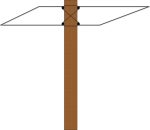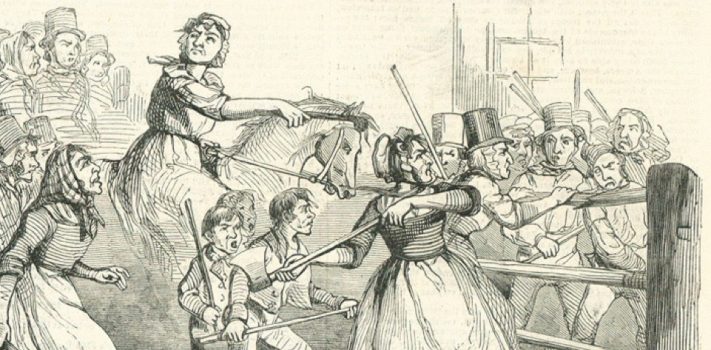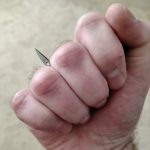(Continued from Part 4.)
Blunt Force Projectiles
Picking up something and throwing it at an attacker or game is another deep-seated instinct most people have, and it provides a number of additional options for weapons. A 9oz. projectile thrown at 45mph results in around 40 ft-lb of kinetic energy at impact, which is enough to break some smaller bones and cause a concussion. Throwing something accurately and hard enough to do damage requires a lot more practice than just swinging a club, but it can give you a stand-off capability to mitigate threats before they can get close to you.
As with clubs, there are a number of alternative and improvised options that you can leverage. One thing to keep in mind is that once you’ve thrown something there’s a chance you won’t be able to retrieve it, so you should plan on having multiple projectiles and/or alternate weapons options available. Some possible examples include:
- Rocks/Bricks/Concrete – The simplest things you can throw are what you often find laying around. The potential issues with this approach are that you have to assume you’ll have something laying around when you need it, you’ll have to stop and pick it up, and the things you find will have inconsistent sizes, shapes and weights, which makes them harder to throw accurately.
- Baoding Balls – Theses are metal or stone balls that you roll around in your hand for exercise and stress relief. The 1.5” solid stainless steel ones weigh 9oz. each, and the solid gemstone ones weigh around 3oz. – both of them make very effective projectiles and can be carried pretty much anywhere. After a lot of practice I can consistently hit a human head-sized target from 20’ to 25’ feet away, and the 1.5” solid steel ones will crack ¼” plywood from that distance. You can also use less expensive 1”-2” steel ball bearings.
- Clubs – Any of those fixed and flexible clubs discussed in the previous section can be thrown, but that means you won’t have a club if you fail to stop the attacker and they close on you. Clubs also tend to fly unevenly, so they’re not the best option for a blunt force projectile.
- Sports/Game balls – Some hard balls from sports and games like golf, pool/billiards, cricket, and baseball can make effective projectiles and can be carried almost anywhere.
- Cell phone – Something that almost everyone carries which can make a very effective projectile, although practicing might get expensive.
- Sling – A sling is basically two lengths of cord with a small pouch attached in the middle, used to throw projectiles with great force. I’ve always carry a sling in my backpack and never had any security or law enforcement take a second look. You can find rocks or nuts to use as ammo, or carry a bracelet/necklace/prayer string with steel beads on it. Using a sling accurately requires a good amount of practice.
- Slingshot – I discussed slingshots extensively in a previous article, including how to improvise one in the field, so I’m not going to repeat that here.
Having a couple of blunt force projectiles can add depth to your defensive strategy by giving you the ability to impact an attacker at longer range, then switching to a club or other extended reach weapon when they get closer. As with the disruptive weapons I recommend that you practice throwing with your weak hand so you can retain a closer in weapon in your strong hand without having to take any additional actions.
Penetration Weapons
The next class of weapons are those with points or sharp edges designed to cut or puncture an attacker. These have the potential to cause more serious injuries and are much more likely to be considered a serious offense if found in your possession by law enforcement. Hence the majority of these types of weapons will most likely need to be improvised when in more dangerous situations where law enforcement may no longer be a factor or they are focused on other problems.
There aren’t a lot of different types of options available for cutting/penetration weapons, so I’m going to group all of them here. Some options include:
- Shiv – If you’ve ever watched a prison movie you’ve probably seen a shiv, which is nothing more than a pointed piece of hard material you use to stab someone with. Shivs can be made from wood, metal, plastic, glass, ceramic, etc. and improvised from items like knitting needles, chopsticks (metal ones are better), pencils (9H are the hardest), screwdrivers, tent stakes, scissors, etc. Shivs are generally shorter to assist in concealment, but can be any length you can effectively handle. You can saw a piece of metal tubing at a sharp angle using the Shomer-Tec mentioned earlier, then use the file to fine tune the point. Here’s an example of one made from copper tubing:
 Depending on the material you may want to wrap the body in tape or material to improve your grip or to keep from cutting your hand. Another option for an improvised shiv is to take a cheap plastic ballpoint pen, remove the ink cartridge and replace it with a piece of sharpened wire (coat hanger wire is usually the right size).
Depending on the material you may want to wrap the body in tape or material to improve your grip or to keep from cutting your hand. Another option for an improvised shiv is to take a cheap plastic ballpoint pen, remove the ink cartridge and replace it with a piece of sharpened wire (coat hanger wire is usually the right size).
- Spear – A spear is basically a stick or pole with a sharp tip, which can injure an attacker while staying out of their range. They can also be fashioned by attaching a shiv to a stick or pole. Note that spears should be held and used to stab an attacker, not thrown (unless you’re very skilled at throwing a spear or you have a large supply of them available). Spears and spear tips can be easily fashioned from a number of different materials such as wood sticks, metal, PVC pipe, etc. For wooden spears you should consider drying (not burning) the tip over a fire to remove the moisture and make it harder, although this will also make it more fragile.
- Darts – Darts are basically shafts with a sharp heavy tip on the front and fins on the back to provide stability in flight and are designed to be throw at your target. You can make some reasonably effective darts from an 8”-10” length of coat hanger wire with a sharpened point, some small nuts or washers glued or taped about 2”-3” back from the tip for weight, and some fins made out of duct tape. Larger and more effective darts (think Lawn Darts) can be improvised using heavier materials. These include darts called ‘plumbata’, which the Romans used to great effect. Darts can be an effective method of distracting an attacker, but you probably won’t be able to cause any serious injuries.
- Spike Tomahawk – Similar to the war ax I mentioned earlier, but with sharpened spikes instead of a stone club. Here’s a diagram of one I made many years ago that’s since disappeared somewhere in my shop:
 I took a piece of 2 ½” wide 1/8” thick steel that I found, cut the two ends to points, cut some notches on the top and bottom and attached it to a split wooden shaft with some steel wire. It was amazingly strong and I could sink the points a couple of inches into a log.
I took a piece of 2 ½” wide 1/8” thick steel that I found, cut the two ends to points, cut some notches on the top and bottom and attached it to a split wooden shaft with some steel wire. It was amazingly strong and I could sink the points a couple of inches into a log.
Out of all of the penetration-type weapons, a spear is probably going to be the most useful, since it can provide a reasonably long-range stand-off defensive capability and doesn’t require a lot of practice to use effectively. The biggest potential issue is having the attacker grab it, so you need to use it decisively to stab their arms, legs, head or torso, not poke at them like you’re trying to wake up a bad-tempered sleeper.
Fist Loading
Fist loading involves reinforcing your fist and knuckles with weight and/or hard material to increase the effectiveness of your punch. If you’ve ever actually punched someone in their face then you know that it can be just as painful for you as it is for them, since your knuckles are essentially just skin over bone. The most obvious tool for fist loading is brass knuckles, which are illegal pretty much everywhere. However, there are some good alternative and improvised options you can use:
- Reinforced gloves – These are gloves with hard plastic inserts over your knuckles to minimize the impact to you.
- Kubaton – These are short sticks with one or both ends pointed that you hold in your fist – they’re meant to be used to hit an opponent with the point in place of your knuckles, with the force of the blow concentrated at the point. You can also use a pen in a similar manner, although I’ve had pens that look too ‘tactical’ confiscated by security in the past. An innocuous alternative is a multi-section tubular aluminum pill holder – the knob on one end that’s designed to hold a ring works to concentrate the force in place of an actual point.
- JWR Adds: Rolls of dimes or quarters. Make your choice based on the size of your hands. This doesn’t provide any protection for your knuckles, but it does add a lot of weight to your punches. This is just money in another form, and thus it is easy to explain why it is in your pocket. (That is if you don’t reinforce the roll with duck tape!)
- Defense ‘Key’ – There are several manufacturers that make a small plastic or metal devices designed to be held in your palm with the tip facing out through your fingers – when you hit somebody the tip scratches and possibly penetrates their skin, causing significantly more damage than just using your fist could. Some of them like the Guardian Self Defense Stinger can’t be mistaken for anything else, so you’ll probably get in trouble if you’re caught with one. My favorite alternative for when I’m carrying a Swiss Army Knife is to hold it in my palm with the Phillips screwdriver or awl on the back sticking out between my fingers like this:
 Carabiner – Remember that carabiner on my water bottle I mentioned earlier? It makes a great knuckle reinforcement when you need to punch someone, and it’s something no one will ever look twice at. You’ll typically need a larger one to fit over your hand – options like Xtec, FresKaro and GPCA work well, and you’ll want one with a locking gate so it doesn’t come open and rip your hand when you hit something. I’m pretty conscious about limiting the weight of what I carry, so I invested the money and got the titanium version of the GPCA X Grip. With the First Strike whip wire attached to it I have both a defense whip and knuckle reinforcement in one easy to hold device that I can hide up my sleeve and hold in place with a rubber band until I need it. Here’s what it looks like held in my hand:
Carabiner – Remember that carabiner on my water bottle I mentioned earlier? It makes a great knuckle reinforcement when you need to punch someone, and it’s something no one will ever look twice at. You’ll typically need a larger one to fit over your hand – options like Xtec, FresKaro and GPCA work well, and you’ll want one with a locking gate so it doesn’t come open and rip your hand when you hit something. I’m pretty conscious about limiting the weight of what I carry, so I invested the money and got the titanium version of the GPCA X Grip. With the First Strike whip wire attached to it I have both a defense whip and knuckle reinforcement in one easy to hold device that I can hide up my sleeve and hold in place with a rubber band until I need it. Here’s what it looks like held in my hand:
If you’re using your fists then it means the attacker has gotten close and can hit you, so any kind of fist or knuckle loading should be considered a last resort.
(To be concluded tomorrow, in Part 6.)











